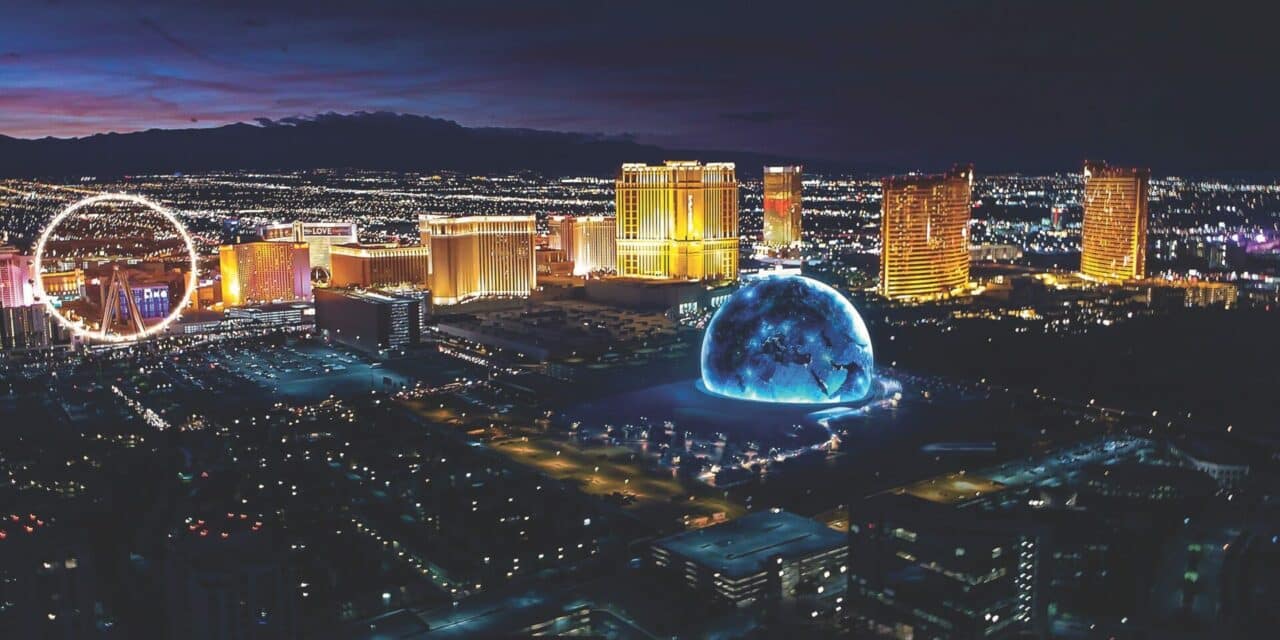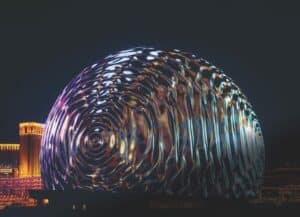SPHERE AND NOW: The Las Vegas Sphere lights up the Sin City skyline. (Courtesy MSG)
Venue takes major step toward its Sept. 29 opening
LAS VEGAS – The Las Vegas Sphere took a major step toward its Sept. 29 opening, when U2 will kick off the first of 25 scheduled performances of “U2:UV Achtung Baby Live At Sphere,” with the unveiling of the venue’s impressive state-of-the-art audio system. Sphere Immersive Sound, powered by HOLOPLOT, which is being called the “world’s most advanced concert-grade audio system,” features 3D beam-forming sound that can be focused on specific seats throughout the venue’s vast performance space without audio decay.
A demonstration of the cutting-edge audio on Friday, July 21, from inside the massive Sphere more than lived up to its billing. Here, James Dolan, Executive Chairman and CEO, MSG Entertainment, David Dibble, CEO, MSG Ventures, Roman Sick, CEO, HOLOPLOT and Paul Freeman, Principal Audio Artist for Sphere, explained how the audio system works and why they dedicated themselves to the task.
“Sound is key and we paid a great deal of attention to it,” said Dolan in his introductory remarks addressing roughly a dozen or so journalists sitting in a central tier of the massive structure. “What we have created here is as close as you can get in a full venue of replicating the human sense of sound. And we’re programming to it, and everything [you’ll hear] now is because of the technology we’re using, everything that you hear is intentional. Not causal. Meaning that once you hear it, you’ll know it yourselves.”
Sitting inside the colossal 160,000 square foot concave $2.3 billion Sphere amidst millions of dormant LED lights and 17,500 seats, it’s hard not to be impressed by the sheer size and scope of the project. The interior, which extends 366 vertical feet, is taller than the Statue of Liberty. And once the audio kicked in, the experience went to another level with warm pristine sound enveloping the entire space.
“From the beginning, HOLOPLOT has been focused on radically transforming audio technology, rethinking the underlying physics of sound reproduction as we know it,” stated Roman Sick, CEO of HOLOPLOT, an audio technology company founded in Berlin in 2016. The audio technology, he explained, was first implemented as a public address system for the Deutsche Bahn (German train system) making announcements audible. The technology is currently in use at MSG’s Beacon Theatre.
During the audio demonstration, Freeman simply touched his handheld tablet and suddenly 167,000 amplified loudspeaker drivers, housed in 1,600 permanently installed HOLOPLOT X1 loudspeaker modules placed around the Sphere, along with another 300 mobile modules, fired up creating crisp, clean, high-quality audio, which sounded as if the speakers were directly in front of you rather than hundreds of feet away.
The first track played through the audio system, most appropriately, was U2’s “Pride In The Name of Love (Pride Mix)” from the group’s 2023 album Songs of Surrender mixed specifically for the Sphere (and devoid of 1984’s anthemic Unforgettable Fire bombast). The acoustic and more plaintive version of “Pride” sounded as if the system were using high-fidelity studio stems with each individual part flushed out. Bono and The Edge’s ragged, glorious harmonies honed over decades warmly rose above reverberating strummed acoustic guitar chords before a booming bass came in from every possible direction. The experience wasn’t just passively listening to a song, but instead felt like being inside the mix with sound waves enveloping all and everything.
“The beauty of Sphere is not only the ground-breaking technology that will make it so unique, with the world’s most advanced audio system integrated into a structure which is designed with sound quality as a priority,” U2’s The Edge said in a statement. “It’s also the possibilities around immersive experiences in real and imaginary landscapes. “In short, it’s a canvas of an unparalleled scale and image resolution, and a once-in-a-generation opportunity….”
During the demo, Freeman played a song with vocals and asked the roughly 20 or so gathered where the voice was coming from. Depending on where one sat, the answers were different with everybody pointing in different directions. At another juncture, he played The Beatles’ “Here Comes The Sun,” as a way of showing how the audio technology can highlight sounds never before noticed. In this case, it was George Harrison’s foot tapping during the song’s recording, an audio revelation.
Freeman curated a varied mix of genres and sounds demonstrating Sphere’s ability to create immersive audio experiences from any oeuvre. A track by the band Tauk had an electronic feel with Giorgio Moroder-like synthesizer; London Grammar’s “California Soil,” featured Hannah Reid’s soaring vocals over a trip-hop beat; Tiësto and Sevenn’s “BOOM” was all low-end bass with heavy percussive beats and ready for the dance floor; much like J.Lo’s “On The Floor” featuring Pitbull chanting over banging EDM pop; Queen’s wildly dynamic “Bohemian Rhapsody” may never have sounded more dynamic or omnipresent; and an ambient soundscape of maybe birds, crickets and rustling leaves evoked a forest setting.
Freeman, who is also the CEO of Audio By The Bay Productions, played a sweeping classical film score that was recorded at Abbey Road Studios with legendary conductor John Williams. One can imagine such an epic soundtrack being used in director Darren Aronofsky’s “Postcard From Earth” film, which will debut at Sphere on Oct. 6.
“Sphere Immersive Sound is a cornerstone of the custom-designed technology that will make Sphere unlike any venue, anywhere in the world, providing audio with unmatched clarity and precision to every guest, no matter where they are seated,” stated David Dibble CEO, MSG Ventures. Dibble noted during the demonstration how the structure resembles the venues of ancient Greece, which brought attendees as close to the performance as possible. He also explained how the seats have haptic technology, which during the demonstration brought vibrations to the seats, which are covered in a waffle-like texture that reacts similarly to human skin so Sphere’s audio remains constant and uniform even when not full.
“The sound for a musician is really the product,” James Dolan said when summarizing the Sphere’s audio technology. “What a musician wants is to connect with their audience. They want the intention of their sound to reach their audience. And that intention is what they write in their music. And no building in the world will do that better than the one you’re sitting in right now.”
—
All Of The (Fully Programmable) Lights: The Sphere Is Lighting Up The Strip
Sometimes what happens in Vegas doesn’t stay in Vegas – even at 4:30 a.m. on a national holiday. But when you’ve invested $2.3 billion into Sphere, the new 17,500-capacity leading-edge venue that opens in late September with “U2: UV Achtung Baby Live,” and you’re on the verge of completely lighting up 580,000 square feet of fully programmable LED exosphere – the largest in the world, you have to take it for a spin – even if that means someone films and posts it on the web before the official illumination.
“We had to, this was the first time we’ve ever turned this building on in this manner,” says Alex Luthwaite, SVP Show Systems for Madison Square Garden Ent. “It’s the first time we’ve ever produced content and had media servers play in this manner. We did all the testing with our 1/40th scale model in our Burbank studio, so we were fairly confident, but when all the press is pointing cameras at it for July 4th, we wanted to be 100% confident. So we did a test very early in the morning to give us confidence, which was about color calibration and things like that. After that, we felt good.”
If Luthwaite and Sphere’s team felt good during the beta test, imagine their jubilation later that day with the exterior fully illuminated. The Las Vegas skyline was transformed with the giant glowing orb and its powerful succinct HAL-9000-like message: “Hello World.” The exosphere then morphed through numerous colors and modes from tie-dye, moonscape and cascading stars that made the Sphere appear to spin to fireworks, Ol’ Glory and more. It was transfixing and its execution, by all accounts and captured on a dazzling YouTube video, looked flawless and perhaps appeared easy to execute.
It wasn’t in any way.
“We’ve been working towards this for a number of years with a lot of partners and technologies,” says Luthwaite, who mentions SACO Technologies and 7thSense. Luthwaite, who formerly worked on the London Olympics ceremonies, says he had his “finger in multiple pies,” adding, “I was like the glue in the middle of all the different teams. I wasn’t involved with architecture or the physical construction, but I was very involved with the LED manufacturing because I have a lot of experience doing that. I had to make sure everybody was communicating with everyone else and helped see the process through, but ultimately there were different heads responsible for each piece.”
Those different teams and workflows included parametric modeling, architectural design, steel fabricators, LED manufacturing, construction (including bolting the LEDs to the frames and lifting the frames into place, “you have to be extremely accurate, otherwise the image doesn’t work,”) media servers, electricians, content creators and artists and more. All of which means it took a cast of thousands to light up Sphere’s exterior.
The teams had to account for the ability to service and access the vast amount of individual parts. “An enormous amount of thought went into the process of making this very fast, very efficient and very modular,” he says. “Most of it got built on the ground in very large sections. There’s basically parallelogram spirals that roll around the building which is part of the architecture. The (1.2 million) LED pucks fit into that architectural framing and they’re enormous. They were built and assembled on the ground with giant frames, which was more achievable than dangling 300 feet in the air. Then they were lifted with cranes. It was a choreography to design, manufacture and assemble with different partners at each stage. it was a monumental effort.”
Illuminating the exosphere, Luthwaite says, is not the same as illuminating the interior. “The outside is easy in comparison,” he says. One is spherical and outdoors and the other concave, indoors and part of a performance. “There’s 250% more resolution on the inside than the outside,” he said. “The exterior is a sub 4K image, the interior is a 16K x 16K image, so it’s considerably higher resolution. To explain in a different way, the exosphere runs on one very powerful media server, the interior uses 25.”
With less than three months before U2 graces Sphere’s stage, Luthwaite is confident they’ll be ready. “I feel good about it,” he says. “I was there last week, we did some internal testing and it’s all mostly working. We still have to put together some control elements to make it go from an okay show to a really wow show. We’re getting there.”








